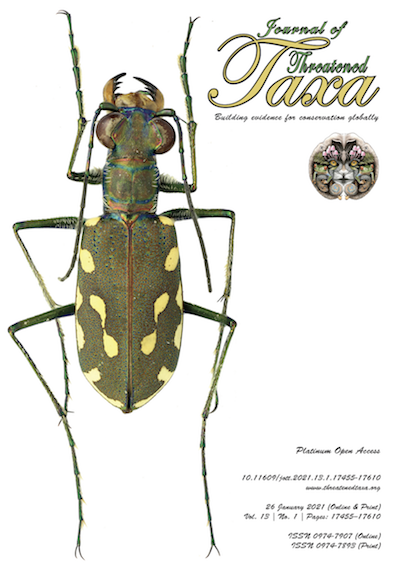Record of the world’s biggest pangolin? New observations of bodyweight and total body length of the Indian Pangolin Manis crassicaudata Gray, 1827 (Mammalia: Pholidota: Manidae) from Mannar District, Sri Lanka
Main Article Content
Abstract
The Indian Pangolin Manis crassicaudata is one of the eight extant pangolin species in the world, occurring in the Indian subcontinent and is the solitary pangolin species recorded in Sri Lanka. Little is known about the intra-specific morphometric variations of the Indian Pangolin, largely due to the limited observations. In this note, we report the morphometrics of the largest Indian Pangolin recorded so far in its range, and consequently the largest pangolin ever to be recorded according to published information. These records along with observations from other range countries provide novel insights into the maximum growth of male Indian Pangolins.
Article Details

This work is licensed under a Creative Commons Attribution 4.0 International License.
Authors own the copyright to the articles published in JoTT. This is indicated explicitly in each publication. The authors grant permission to the publisher Wildlife Information Liaison Development (WILD) Society to publish the article in the Journal of Threatened Taxa. The authors recognize WILD as the original publisher, and to sell hard copies of the Journal and article to any buyer. JoTT is registered under the Creative Commons Attribution 4.0 International License (CC BY), which allows authors to retain copyright ownership. Under this license the authors allow anyone to download, cite, use the data, modify, reprint, copy and distribute provided the authors and source of publication are credited through appropriate citations (e.g., Son et al. (2016). Bats (Mammalia: Chiroptera) of the southeastern Truong Son Mountains, Quang Ngai Province, Vietnam. Journal of Threatened Taxa 8(7): 8953–8969. https://doi.org/10.11609/jott.2785.8.7.8953-8969). Users of the data do not require specific permission from the authors or the publisher.
References
Algewatta, H.R., P. Perera, H.Karawita, N.Dayawansa, D. Manawadu & M. Liyanage (2021). Updates on the Morphometric Characterization of Indian Pangolin (Manis crassicaudata) in Sri Lanka. Animals 11(1): 25. https://doi.org/10.3390/ani11010025
Coulson, I. (1989). The pangolin {Manis temmincki Smuts, 1835) in Zimbabwe. African Journal of Ecology 27(2): 149–155. https://doi.org/10.1111/j.1365-2028.1989.tb00938.x
Hatt, R.T., H. Lang & J.P. Chapin (1934). The pangolins and aard-varks collected by the American Museum Congo expedition, 643–672pp. https://hdl.handle.net/2246/1011
Irshad, N., T. Mahmood & M.S. Nadeem (2016). Morpho-anatomical characteristics of Indian pangolin (Manis crassicaudata) from Potohar Plateau, Pakistan. Mammalia 80(1): 103–110. https://doi.org/10.1515/mammalia-2014-0179
Karawita, H. & P. Perera (2020). A method for rapid assessment of the distribution and conservation status of Indian Pangolin (Manis crassicaudata) in an extended geographical region. MethodsX 7: 100912. https://doi.org/10.1016/j.mex.2020.100912
Karawita, H., P. Perera, N. Dayawansa & S. Dias (2020). Dietary composition and foraging habitats of the Indian Pangolin (Manis crassicaudata) in a tropical lowland forest-associated landscape in southwest Sri Lanka. Global Ecology and Conservation 21: p.e00880. https://doi.org/10.1016/j.gecco.2019.e00880
Karawita, H., P. Perera, P. Gunawardane & N. Dayawansa (2018). Habitat preference and den characterization of Indian Pangolin (Manis crassicaudata) in a tropical lowland forested landscape of southwest Sri Lanka. PloS one 13(11): p.e0206082. https://doi.org/10.1371/journal.pone.0206082
Kingdon, J. (1971). East African mammals. An Atlas of Evolution in Africa, Primates, Hyraxes, Pangolins, Protoungulates, Sirenians, vol. I. Academic Press, London, 446pp.
Kingdon, J. & M. Hoffmann (2013). Phataginus tetradactyla – Long-tailed Pangolin, pp. 389–391. In: Kingdon, J., & M. Hoffmann (eds.). Mammals of Africa, Vol. V, Carnivores, Pangolins, Equids, Rhinoceroses. Bloomsbury Publishing, London, 560pp.
Mahmood, T., D. Challender, A. Khatiwada, S. Andleeb, P. Perera, S. Trageser, A. Ghose & R. Mohapatra (2019). ‘Manis crassicaudata, Indian Pangolin’, The IUCN Red List of Threatened Species. https://doi.org/10.2305/IUCN.UK.2019-3.RLTS.T12761A123583998.en
Mahmood, T., R.K. Mohapatra, P. Perera, N. Irshad, F. Akrim, S. Andleeb, M. Waseem, S. Sharma & S. Panda (2020). Indian Pangolin Manis crassicaudata (Geoffroy, 1803), pp. 71–88. In: Challender D.W.S., H.C. Nash & C. Waterman (eds.). Pangolins. Academic Press, USA, 658pp. https://doi.org/10.1016/B978-0-12-815507-3.00005-8
Mohapatra, R.K., S. Panda, & M.V. Nair (2015). On the mating behaviour of captive Indian pangolin (Manis crassicaudata). Taprobanica: The Journal of Asian Biodiversity, 7(1): 57–59. https://doi.org/10.4038/tapro.v7i1.7175
Newton, J., L. Bussière, K. Abernethy & D. Lehmann (2019). Ecology and Conservation of Pangolin Using Stable Isotope Forensics. [online] University of Glasgow, Scottish Universities Environmental Research Centre, https://www.gla.ac.uk/media/Media_700297_smxx.pdf, Electronic version accessed on 19 July 2020.
Pabasara, M.G.T., P. Perera & N. Dayawansa (2015). A Preliminary investigation of the habitat selection of Indian Pangolin (Manis crassicaudata) in a Tropical lowland forest in south-west Sri Lanka. Proceedings of International Forestry and Environment Symposium, 2015.
Perera, P. & H. Karawita (2020). An update of distribution, habitats and conservation status of the Indian pangolin (Manis crassicaudata) in Sri Lanka. Global Ecology and Conservation 21: p.e00799. https://doi.org/10.1016/j.gecco.2019.e00799
Perera, P.K.P., K.V.D.H.R. Karawita & M.G.T. Pabasara (2017). ‘Pangolins (Manis crassicaudata) in Sri Lanka: A Review of Current Knowledge, Threats and Research Priorities’, Journal of Tropical Forestry and Environment 7(1): 1–14. https://doi.org/10.31357/jtfe.v7i1.3018
Philips , W. (1926). A guide to the mammals of Ceylon. Part V. The pangolin. Spolia Zeylanica 13: 285–289.
Roberts, T.J. & Bernhard (1977). The Mammals of Pakistan. Ernest Benn Limited, London, 361pp.
Sharma, S.K. (2002). Abnormal weight and length of the Indian Pangolin Manis crassicaudata Gray, 1827, from Sirohi District, Rajasthan. Journal of the Bombay Natural History Society 99(1): 103–104.
Sulaiman, M.H., W.A. Azmi, M. Hassan & J.L. Chong (2017). Current updates on the morphological measurements of the Malayan Pangolin (Manis javanica). Folia Zoologica 66(4): 262–266. https://doi.org/10.25225/fozo.v66.i4.a8.2017
Ullmann , T., D. Veríssimo & D.W.S. Challender (2019). Evaluating the application of scale frequency to estimate the size of pangolin scale seizures. Global Ecology and Conservation 20: p.e00776. https://doi.org/10.1016/j.gecco.2019.e00776
Weerakoon, D.K. (2012). The taxonomy and conservation status of mammals in Sri Lanka, pp. 134–144. In: Weerakoon, D.K. & S. Wijesundara (eds.). The National Red List 2012 of Sri Lanka, Conservation Status of the Fauna and Flora. Ministry of Environment in Sri Lanka, viii+476pp.
Shibao, W., L. Naifa, Z. Yingmei, O. Zhi & C. Hai (2004). Measurement and comparison for skull variables in Chinese pangolin and Malayan pangolin. Acta Theriologica Sinica 24(3): 211–214.

